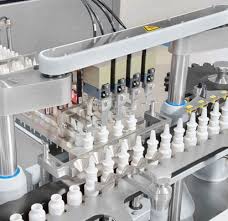|
Getting your Trinity Audio player ready... |
Understanding Tinctures and the Tincture Filling Line
What is a Tincture?
tincture is a concentrated liquid extract derived from plant or animal sources. The extraction process primarily uses ethanol due to its effectiveness in dissolving both acidic and alkaline components. However, other solvents can also be used for extraction, including:
- Vegetable glycerin
- Apple cider vinegar
- White vinegar
- Propylene glycol
- Diethyl ether
Tinctures are widely used for their convenience and ease of administration. Since they are liquid-based, they can be precisely measured and administered in small doses, making them particularly suitable for children and individuals who struggle with swallowing pills. The solvent concentration in a tincture typically ranges between 25% and 60%, but in some cases, it may reach up to 90%, depending on the extraction requirements and intended use.
Key Components of a Tincture Filling Line
A tincture filling line consists of several components working together to facilitate the efficient and accurate filling of bottles. While specific configurations may vary by manufacturer, the fundamental elements of a tincture filling system include:
- Fluid Filling Point
- This is where the tincture solution is stored before being dispensed into bottles.
- Peristaltic Pump
- This pump controls the flow of tincture into the filling heads. It ensures consistent and precise distribution of liquid into bottles.
- Capping Unit
- This section secures caps onto the bottles after they have been filled.
- Electrical Unit
- Houses all electrical components required to operate the tincture filling line. It also supplies power to various parts of the system.
- Filling Station
- The designated area where bottles are accurately filled with tincture.
- Motors
- Converts electrical energy into mechanical energy, driving different parts of the machine.
- Dropper Feeder
- A component that inserts a dropper into each bottle, ensuring precise dispensing of the tincture when in use.
- Conveyor Belt
- Moves bottles from one station to the next, ensuring a smooth production flow.
- Control Panel
- Contains the user interface, including a programmable logic controller (PLC) and a human-machine interface (HMI), allowing operators to monitor and control the process efficiently.
- Sensors
- Detects the presence of bottles at the filling station, ensuring minimal waste by preventing spillage when no bottle is detected.
- Bottle Support
- Holds bottles in place during the filling process to ensure precision.
- Holding Area
- Stores empty bottles before they are moved to the filling station.
- Filling Heads
- Dispenses tincture into bottles, ensuring accurate and consistent filling across the production line.
How a Tincture Filling Line Works
The tincture filling process involves several critical steps, ensuring precision, efficiency, and minimal wastage. Below is a breakdown of how the tincture filling line operates:
1. Preparation
Before starting the process, the operator checks the machine to ensure it is in optimal working condition. The tincture is then loaded into the holding tanks, and empty bottles are placed in the holding area. The operator then sets the required filling parameters via the control panel, such as:
- Desired tincture volume per bottle
- Filling speed
Once all parameters are configured, the system is activated to commence the filling process.
2. Filling Process
The conveyor belt moves empty bottles towards the filling station. As bottles arrive, sensors detect their presence and activate the filling mechanism. The peristaltic pump directs the tincture into the filling heads, which dispense the liquid into the bottles. Once the predetermined volume is reached, the filling heads automatically stop, preventing overflow or wastage.
3. Dropper Insertion and Capping
After filling, a dropper is inserted into each bottle via the dropper feeder. The capping unit then securely seals each bottle with a cap, ensuring the tincture remains uncontaminated and properly stored.
4. Quality Control and Exit
Once capping is completed, the filled and sealed bottles pass through a quality control checkpoint. Sensors detect and reject any faulty bottles before they leave the production line, ensuring only properly filled and sealed products are packaged for distribution.
Applications of a Tincture Filling Line
Tincture filling lines are used across various industries to fill different types of liquid-based products, including:
- E-cigarette oils
- Eye drops
- Cosmetic products (e.g., eye shadow, nail polish)
- Essential oils
- Cannabis extracts
Factors to Consider When Choosing a Tincture Filling Line
Selecting the right tincture filling line requires careful consideration of multiple factors. Below are some critical aspects to evaluate:
- Tincture Viscosity
- The flow rate of the tincture will influence the type of pump and filling mechanism required.
- Pump Filler Type
- Ensures accurate and consistent filling, whether operating on a pulse or time-based system.
- Bottle Type and Size
- The bottle’s shape and volume determine the compatibility of the filling line.
- Filling Rate
- Fully automated systems offer higher output compared to semi-automatic alternatives.
- Filling Volume
- The system should support either liquid level-based or volumetric filling methods.
- Holding Tank Capacity
- Larger tanks reduce the need for frequent refilling, optimizing efficiency.
- Compliance with Quality Standards
- Ensuring the machine meets international safety and quality regulations.
- Material Durability
- Stainless steel components offer longevity and resistance to corrosion.
- Budget Constraints
- Balancing affordability with performance and operational needs.
- Technology Integration
- Advanced features enhance efficiency and ease of use.
- Machine Configuration
- The design should align with the available workspace and production scale.
- Maintenance Requirements
- Ease of servicing and availability of spare parts reduce downtime.
Advantages of a Tincture Filling Line
Using a tincture filling line offers numerous benefits, including:
- Low power consumption – Energy-efficient designs minimize operational costs.
- Automation – Fully automated models enhance productivity and accuracy.
- Space-saving – Some models require minimal floor space.
- Versatile bottle handling – Adjustable settings accommodate different bottle sizes.
- Consistency – Ensures uniform filling and adherence to quality standards.
- Time efficiency – Rapid processing capabilities increase output.
- User-friendly operation – Automated systems require minimal training for operators.
Limitations of a Tincture Filling Line
Despite the advantages, there are some challenges associated with tincture filling machines:
- High Initial Cost – Purchasing a high-quality machine requires significant investment.
- Power Demand – Large-scale units consume more electricity, increasing expenses.
- Limited Product Range – Can only process liquid-based products.
- Operator Training – Employees must be trained to operate and troubleshoot the system.
- Maintenance Needs – Specialized technicians may be required for servicing and repairs.
Quality Standards for Tincture Filling Line
To ensure safety and compliance, tincture filling lines must meet standards such as:
- RoHS: Restricts hazardous substances.
- CE Marking: Required for European markets.
- cGMP: Ensures consistent, high-quality production.
Comparison: Tincture Filling Line vs. Vial Filling Line
- Tincture Filling Line: Used for plant/animal extracts in bottles.
- Vial Filling Line: Designed for pharmaceutical vial packaging.
Comparison: Tincture Filling Line vs. Bottle Filling Machine
- Tincture Filling Line: Specifically for liquid extracts.
- Bottle Filling Machine: Handles liquids, semi-solids, and solids.
Maintenance Practices for Tincture Filling Line
To ensure longevity:
- Lubricate moving parts.
- Repair/replace faulty sensors.
- Clean regularly to prevent dust buildup.
- Check electrical components for safety.
- Conduct routine inspections.
- Use genuine replacement parts.
Semi-Automatic vs. Fully Automatic Tincture Filling Line
- Fully Automatic: Higher efficiency, advanced technology, and higher cost.
- Semi-Automatic: Requires some manual intervention, lower cost.
Factors Affecting Tincture Filling Line Efficiency
- Power Output: Ensure correct voltage supply.
- Operator Skill: Trained staff improve performance.
- Maintenance: Regular servicing prevents breakdowns.
Choosing a Tincture Filling Line
Key specifications to consider:
- Machine design and size.
- Filling speed.
- Power consumption.
- Bottle shape and size compatibility.
Troubleshooting Tincture Filling Line Issues
- Power Problems: Check power supply or generator backup.
- Inconsistent Filling: Adjust settings on the control panel.
- Dripping/Foaming: Tighten valves and bottle caps.
Bottle Materials for Tincture Filling Line
The machine can handle bottles made from:
- Glass
- Plastic
- Aluminum
Types of Liquid Filling Machines
- Net weight fillers
- Pressure/gravity fillers
- Piston fillers
- Overflow fillers
- Hot filling machines
- Isobaric fillers
Validation Documentation
- Design Qualification
- Installation Qualification
- Operational Qualification
- Performance Qualification
Conclusion
A tincture filling line is an essential piece of equipment for industries producing liquid extracts, ensuring efficiency, accuracy, and consistency in the filling process. With varying levels of automation, capacity, and features, businesses can select a system that best fits their production needs. While the initial investment may be high, the long-term benefits—such as reduced labor costs, improved product quality, and higher production speeds—make it a worthwhile investment. By adhering to proper maintenance practices and industry quality standards, a tincture filling line can provide reliable performance for years to come.







Leave a Reply